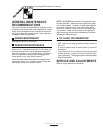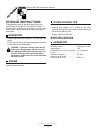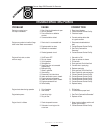
3
Extended Life Generator
GENERAC
Generac Mega 2500 Extended Life Generator
Gasoline is highly FLAMMABLE and its vapors are
EXPLOSIVE. Do not permit smoking, open flames,
sparks or heat in the vicinity while handling gasoline.
Avoid spilling gasoline on a hot engine. Comply with
all regulations requiring storage and handling of gaso-
line.
Do not overfill the fuel tank. Always allow room for
fuel expansion. If tank is overfilled, fuel can overflow
onto a hot engine and cause FIRE or an EXPLO-
SION.
Never store generator with fuel in tank where gaso-
line vapors might reach an open flame or spark or pilot
light (as on a furnace, water heater or clothes dryer).
FIRE or an EXPLOSION might result.
Generator exhaust gases contain DEADLY carbon
monoxide gas. This dangerous gas, if breathed in suf-
ficient concentrations, can cause unconsciousness
or even death. Operate this equipment only in the open
air where adequate ventilation is available.
The engine-generator requires an adequate flow of
cooling air for its continued proper operation. Never
operate the unit inside any room or enclosure where
the free flow of cooling air into and out of the unit might
be obstructed. Without sufficient cooling air flow, the
unit quickly overheats, damaging the generator or
nearby property.
Allow at least 2 feet of clearance on all sides of gen-
erator, even while operating unit outdoors, or you
could damage the unit.
Never start, or stop, the engine-generator with elec-
trical loads connected to receptacles with the
connected devices turned ON. Start the engine and
let it stabilize before connecting electrical loads. Dis-
connect all electrical loads before shutting down the
generator.
Do not insert any object through cooling slots of the
engine-generator. You could damage the unit or injure
yourself.
Never operate generator (a) in rain; (b) in any enclosed
compartment; (c) if engine speed changes; (d) if con-
nected electrical devices overheat; (e) if electrical
output is lost; (f) if engine or generator sparks; (g) if
flame or smoke is observed while unit is running; (h)
if unit vibrates excessively.
GROUNDING THE
GENERATOR
The National Electric Code requires the frame and exter-
nal electrically conductive parts of generator be properly
connected to approved earth ground. Local electrical
codes may also require proper grounding of the unit.
For that purpose, a GROUNDING WING SCREW
(Figure 1) is provided on the cradle frame.
Generally, connecting a No. 12 AWG (American Wire
Gauge) stranded copper wire to the grounding wing
screw and to an earth-driven copper or brass grounding
rod (electrode) provides adequate protection against
electrical shock. However, local codes may vary widely.
Consult with a local electrician for grounding require-
ments in your area. Be sure to keep the ground wire
attached while you connect the electrode.
Properly grounding the generator helps prevent electrical
shock if a ground fault conditions exists in the generator
or in connected electrical devices. Proper grounding
also helps dissipate static electricity, which often builds
up in ungrounded devices.
Figure 1 Location of Grounding Wing Nut


















